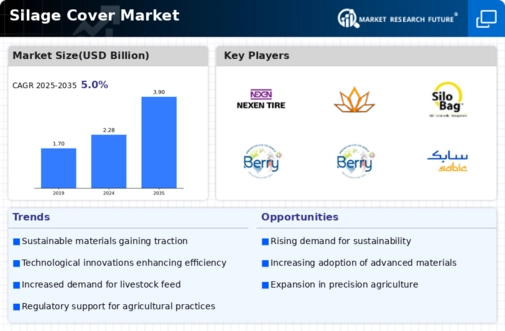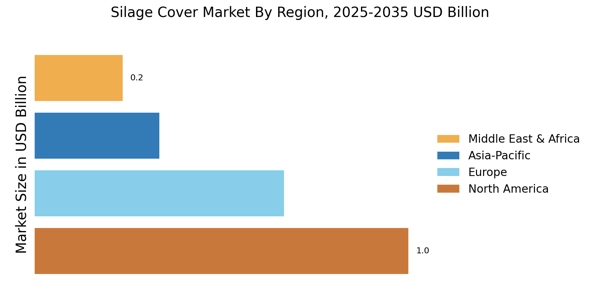Government Support and Subsidies
Government support and subsidies play a vital role in shaping the Silage Cover Market. Many governments are implementing policies aimed at promoting sustainable farming practices, which often include financial incentives for the use of silage covers. These subsidies can significantly lower the cost of purchasing high-quality silage covers, making them more accessible to farmers. For instance, programs that encourage the adoption of environmentally friendly materials are gaining traction, leading to increased investments in the silage cover sector. As a result, the market is likely to expand, with more farmers opting for silage covers that align with government initiatives. This support not only fosters growth in the Silage Cover Market but also encourages the development of innovative products that meet regulatory standards.
Sustainable Agriculture Practices
The increasing emphasis on sustainable agriculture practices is a pivotal driver for the Silage Cover Market. Farmers are increasingly adopting methods that minimize environmental impact while maximizing yield. This shift is evident as the demand for silage covers made from biodegradable materials rises. According to recent data, the market for sustainable agricultural products is projected to grow at a compound annual growth rate of 8.5% over the next five years. This trend indicates a growing awareness among farmers regarding the benefits of using eco-friendly silage covers, which not only protect silage but also contribute to soil health and biodiversity. As sustainability becomes a core principle in farming, the Silage Cover Market is likely to witness a surge in demand for innovative, environmentally friendly solutions.
Rising Demand for High-Quality Feed
The rising demand for high-quality feed is a crucial driver for the Silage Cover Market. As livestock producers strive to enhance the quality of feed for their animals, the importance of effective silage preservation becomes paramount. High-quality silage not only improves animal health but also boosts productivity, leading to increased profitability for farmers. Recent statistics indicate that the livestock feed market is expected to reach USD 500 billion by 2026, with a significant portion attributed to silage-based feeds. This growing demand for superior feed quality is likely to propel the Silage Cover Market, as farmers invest in better silage covers to ensure optimal fermentation and nutrient retention. Consequently, the focus on feed quality is expected to drive innovation and competition within the silage cover sector.
Technological Advancements in Silage Management
Technological advancements in silage management are significantly influencing the Silage Cover Market. Innovations such as automated silage covers and smart monitoring systems are enhancing the efficiency of silage production and storage. These technologies allow farmers to monitor moisture levels and temperature, ensuring optimal conditions for silage preservation. The integration of technology is expected to increase the market size, with projections indicating a growth rate of 7% annually in the next few years. As farmers seek to improve productivity and reduce waste, the adoption of advanced silage management technologies is likely to drive the demand for specialized silage covers that complement these systems. This trend reflects a broader movement towards precision agriculture, where data-driven decisions lead to better resource management.
Increased Awareness of Silage Management Benefits
Increased awareness of the benefits of effective silage management is driving growth in the Silage Cover Market. Farmers are becoming more educated about the advantages of using silage covers, such as improved fermentation, reduced spoilage, and enhanced nutritional value of feed. Educational programs and workshops are being organized to disseminate knowledge about best practices in silage management, which is likely to lead to higher adoption rates of silage covers. Market Research Future indicates that regions with active educational initiatives are experiencing a 10% increase in silage cover usage. This heightened awareness is expected to continue influencing purchasing decisions, as farmers recognize the long-term benefits of investing in quality silage covers. Consequently, the Silage Cover Market is poised for growth as more producers prioritize effective silage management.


















Leave a Comment